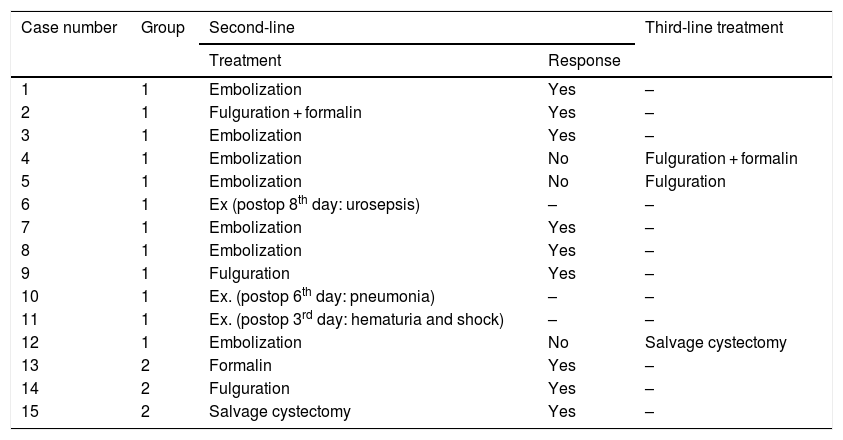Intractable hematuria is a leading critical problem occurring in patients with advanced stage bladder cancer (BCa) that are not suitable for radical cystectomy. The present study, for the first time in the literature, aimed to compare the effectiveness of intravesical formalin (IF) and superselective vesical artery embolization (SVAE) in the management of intractable and life-threatening hematuria in BCa patients.
MethodsThe retrospective study included 40 BCa patients who underwent SVAE or IF treatment due to intractable hematuria after failure of other methods. Patients were divided into two groups based on the procedures administered: SVEA Group (n = 24) and IF Group (n = 16).
ResultsThe success rate at first-line therapy was 50% (12/24) in SVAE Group and 82% (13/16) in IF Group (p = 0.046). Based on the success rates at first- and second-line therapies, the overall success rate in SVAE Group was 75% and this rate was similar to that of IF Group (p = 0.439). Complication rate was significantly higher in IF patients than in SVAE patients (37.5% vs. 8.3; p = 0.024), whereas duration of postoperative hospital stay was significantly longer in SVAE Group (15.8 vs. 6 days; p = 0.041).
ConclusionThe advantages of IF appear to include shorter postoperative hospital stays and higher success rates at a single session, while the advantages of SVAE seem to include non-requirement of spinal/general anesthesia, easy repeatability, and low complication rates. In the management of patients with intractable hematuria, patients’ general condition, comorbidities, and anesthesia-related risks should be taken into consideration.
La hematuria intratable en los pacientes con cáncer de vejiga (CV) en estadio avanzado no subsidiarios de cistectomía radical es una de las condiciones de más complejo abordaje. El objetivo del presente estudio, pionero en la literatura, fue comparar la eficacia de la formalina intravesical (FI) y la embolización supraselectiva de la arteria vesical (ESAV) en el manejo de la hematuria intratable y potencialmente mortal en pacientes con CV.
MétodosEl estudio retrospectivo incluyó a 40 pacientes con CV que se sometieron a tratamiento con ESAV o FI por hematuria intratable tras el fracaso de otros métodos. Los pacientes se dividieron en dos grupos de acuerdo con los procedimientos administrados: grupo ESAV (n = 24) y grupo FI (n = 16).
ResultadosLa tasa de éxito en la terapia de primera línea fue del 50% (12/24) en el grupo ESAV y del 82% (13/16) en el grupo FI (p = 0,046). Con base en las tasas de éxito en los tratamientos de primera y segunda línea, la tasa de éxito global en el grupo ESAV fue del 75%; similar a la del grupo FI (p = 0,439). La tasa de complicaciones fue significativamente mayor en los pacientes de FI que en los de ESAV (37,5% frente a 8,3%; p = 0,024), mientras que la duración de la estancia hospitalaria postoperatoria fue significativamente mayor en el grupo ESAV (15,8 frente a 6 días; p = 0,041).
ConclusiónEntre las ventajas de la FI parecen estar una estancia hospitalaria postoperatoria más corta y mayores tasas de éxito tras una sola sesión, mientras que las ventajas de la ESAV parecen incluir la realización sin anestesia espinal/general, la fácil repetibilidad del procedimiento y las bajas tasas de complicaciones. En el tratamiento de los pacientes con hematuria intratable, se debe tener en cuenta el estado general de los pacientes, las comorbilidades y los riesgos relacionados con la anestesia.









